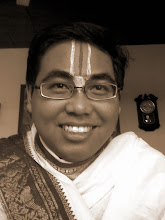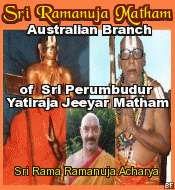 The Trinatha worship as the manifestations of One Supreme Absolute Truth, Paramasiva for the Saivites, Adi Buddha for the Buddhists and Sriman Narayana thus Lord Jagannath for Vaishnava was true Vedic tenets especially developed in Orissa. Even today, the main shrine of worship in every Balinese house was a structure with three compartments. This structure called Kemulan (The Beginning), Sanggar Kawitan (The Shrine of Origin), or just Dewa Hyang (Abode of Revered Lord). Traditionally the ordinary Balinese Hindus considered this shrine as housing deified and sanctified ancestral spirits. After the elaborate rite of Sraddha, might be inherited from its style performed by royal family of Javanese Hindus in older times, the effigy representing the departed souls was buried in the soil of this main shrine. This symbolized the communion of the Atma with the Paramatma.
The Trinatha worship as the manifestations of One Supreme Absolute Truth, Paramasiva for the Saivites, Adi Buddha for the Buddhists and Sriman Narayana thus Lord Jagannath for Vaishnava was true Vedic tenets especially developed in Orissa. Even today, the main shrine of worship in every Balinese house was a structure with three compartments. This structure called Kemulan (The Beginning), Sanggar Kawitan (The Shrine of Origin), or just Dewa Hyang (Abode of Revered Lord). Traditionally the ordinary Balinese Hindus considered this shrine as housing deified and sanctified ancestral spirits. After the elaborate rite of Sraddha, might be inherited from its style performed by royal family of Javanese Hindus in older times, the effigy representing the departed souls was buried in the soil of this main shrine. This symbolized the communion of the Atma with the Paramatma.Ordinary Balinese will said that after this rites their ancestor has became Devas. But once again this term Devas is better substitute by Bhataras, with a more proper meaning. The Balinese understand that after life then the soul will go to its next destinations and get a new body according to its karma. They may reincarnate as human beings, in higher form of lives, or may be lower. So why they said they worship their ancestors in Kemulan? Why did they ignore their own knowledge about destinations of souls as the verdict of the Veda and Sastras? If we take this superficially, then we can’t get any spiritual practices valuable enough to claim as Vaishnavite tenets. This is not Vaishnava practices at all.
 Now I’ll try to take us to the subtle meaning of this important shrine of every Balinese family. We begin from the term ORIGIN. If we talk about origin and worship the origin then that may come to The Supreme Origin of All, Sarva-karana-karanam, The Supreme Lord Sriman Narayana, Sri Jagannath. As we know, because Lord Jagannath manifest Himself in Three Main Forms, and as we said before that the cult of Jagannath take the form of Trinatha worship in Java until it reached Bali, so we can concluded that actually the One worshipped at Kemulan was The Supreme Original Lord Jagannath Himself. This is the esoteric meaning of Kemulan worship. (I didn’t discuss another belief in Balinese Hindu that the left part of Kemulan representing the power of mother, the right of father, and the middle of The Lord Himself. It was enough to say this shrine representing The Origin). Now how could be developed such a belief, that the ancestral Bhataras also resides in Kemulan?
Now I’ll try to take us to the subtle meaning of this important shrine of every Balinese family. We begin from the term ORIGIN. If we talk about origin and worship the origin then that may come to The Supreme Origin of All, Sarva-karana-karanam, The Supreme Lord Sriman Narayana, Sri Jagannath. As we know, because Lord Jagannath manifest Himself in Three Main Forms, and as we said before that the cult of Jagannath take the form of Trinatha worship in Java until it reached Bali, so we can concluded that actually the One worshipped at Kemulan was The Supreme Original Lord Jagannath Himself. This is the esoteric meaning of Kemulan worship. (I didn’t discuss another belief in Balinese Hindu that the left part of Kemulan representing the power of mother, the right of father, and the middle of The Lord Himself. It was enough to say this shrine representing The Origin). Now how could be developed such a belief, that the ancestral Bhataras also resides in Kemulan?Actually the parampara system was exists in Bali for centuries. My short encounter with some of them assured me that the certain spiritual Vedic or Tantric sadhanas were continuously inherited by certain family lineages. Some of them are of course the Javanese Saivite and Buddhist hereditary Brahmin families, the Bhujanga (Vaishnava) lineages, the Pasek, Dukuh, Pande, Bang, and many more. The father or grandfather became spiritual master himself for their children. They give down the spiritual knowledge to their descendants. So actually, when their elder pass away that means their Guru or Acharya went to the Divine Abode of their Istadeva. As our Acharya attain Samadhi, we take him as in eternal communion with Our Lord in Paramapadam, in Sri Vaikuntha, to continue rendering devotional service eternally with other perfected and divine personalities. Thus he became our most worshipful personality, both as our parent and more importantly as our Gurupadapadma. He is our guardian and spiritual protector, thus a Bhatara in Balinese. So, we are always worshipping the Kemulan shrine as the personification of Paramapadam.
As I told you before in previous posts. There are two kind of ordained priestly orders in Bali. The Brahmin high priests and lesser officiating priests from common people. For the Brahmin high priests, of course we could see them clearly following Hindu-Vedic sadhana according to their own particular sects. Because they’re hereditary Brahmins, they learned everything about Vedic knowledge, the secret of mantra and Tantra, and procedures of complicated Vedic rites from their elders, usually from their own father. So it wasn’t uncommon if the Guru was the father of the pupil both spiritually and biologically. They worship their ancestors as their purva-acharyas and also worship the certain Divine Form of The Lord as their hereditary kuladevata and istadevata. Sometime the kuladevata is different from the Istadeva that they worship according to their special hereditary Tantric methods. This kuladevata can be a certain demigod who considered as a protector of the family and their spiritual heir. But usually the Istadeva and kuladeva was same special Divine Form of The Supreme Lord.
The other priestly orders were come from common people. They maintain the temple affairs; serve the daily offerings for the Bhataras, and officiating actively in every temple festivals. They are the core of religious communities attached to the temples. Many of them serve for the temple from the very young age. Others sometime ordered to become priest by mystical arrangement. The Bhataras told him to serve them through dream or words of a medium in trance state. One day I asked one of such a priest. He has been serving at the temple for more than 40 years. “When your time is coming (I mean when he die), where did you think you will go?” Then he said, “Of course I want to go to His place. I hope He will let me continue to serve Him there. Wherever He like, let Him decide for me, so I can serve Him forever. That’s only about my karma or my devotion to Him.”
In other case, according to Vedic beliefs, by funeral rites and after Sraddha ceremony the departed souls will get his Pitri bodies. If he destined to go to Pitriloka, then he will become Pitri under Aryama’s leadership as the lord of ancestral realm. We also believe by subtle mystical way all of us were connected to our Pitris. By remembering them, offering regular Tarpanam, and giving Vishnu-prasadam or Sripada-tirtham, this connection through family lineage will maintained nicely. The Pitris by worshipping Lord Vishnu under Aryama’s direction will send good vibrations toward their descendants in earthly plane. Thus the Pitris also became our Bhataras. From the Kemulan shrine we remember them, offer Vishnu-prasad, Tarpanam, and ask the perfected Bhataras of Paramapadam (the siddha-gurus) to be merciful toward them.

































No comments:
Post a Comment